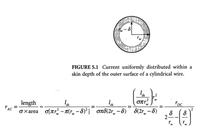CataM
Advanced Member level 4
- Joined
- Dec 23, 2015
- Messages
- 1,275
- Helped
- 314
- Reputation
- 628
- Reaction score
- 312
- Trophy points
- 83
- Location
- Madrid, Spain
- Activity points
- 8,409
Hello everybody,
I have found a formula given by Wheeler which gives the inductance of a flat -single layer- spiral coil assuming the coil is made up of solid wire.
I also have a formula for the AC resistance of a solid wire derived in the book Electromagnetic compatibility Handbook by Kaiser and is very simply derived as follows:

However, my application needs the use of Litz wire in order to reduce as much as possible the AC resistance of the coil due to skin and proximity effect (very high Q of coil is needed).
My question is: Is still accurate to calculate the inductance of the coil using Litz wire with the formula above mentioned which assumes a solid wire is used? If so, I would use the equivalent diameter of the Litz wire as the "solid wire" diameter.
Asking with other words the same question: If one builds an inductor with solid wire, and then builds the same inductor, same geometry, same equivalent diameter and same everything but with the only change that Litz wire is used instead, will the inductance vary ?
As a rough estimation for the resistance, I would assume that the strands are in parallel which makes the AC Resistance of the Litz wire = AC Resistance of 1 of the little wire that makes the boundle/number of strands
But then... why not assume the same for the inductance ? i.e. Inductance with litz wire = Inductance of 1 of the little wire/ number of strands assuming the inductances in parallel because now I can neglect the proximity effect.
Any comment is much appreciated !
I have found a formula given by Wheeler which gives the inductance of a flat -single layer- spiral coil assuming the coil is made up of solid wire.
I also have a formula for the AC resistance of a solid wire derived in the book Electromagnetic compatibility Handbook by Kaiser and is very simply derived as follows:

However, my application needs the use of Litz wire in order to reduce as much as possible the AC resistance of the coil due to skin and proximity effect (very high Q of coil is needed).
My question is: Is still accurate to calculate the inductance of the coil using Litz wire with the formula above mentioned which assumes a solid wire is used? If so, I would use the equivalent diameter of the Litz wire as the "solid wire" diameter.
Asking with other words the same question: If one builds an inductor with solid wire, and then builds the same inductor, same geometry, same equivalent diameter and same everything but with the only change that Litz wire is used instead, will the inductance vary ?
As a rough estimation for the resistance, I would assume that the strands are in parallel which makes the AC Resistance of the Litz wire = AC Resistance of 1 of the little wire that makes the boundle/number of strands
But then... why not assume the same for the inductance ? i.e. Inductance with litz wire = Inductance of 1 of the little wire/ number of strands assuming the inductances in parallel because now I can neglect the proximity effect.
Any comment is much appreciated !
Last edited: